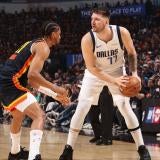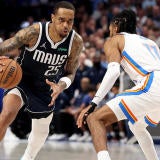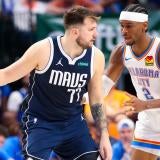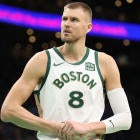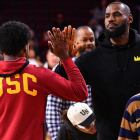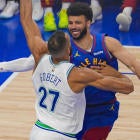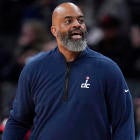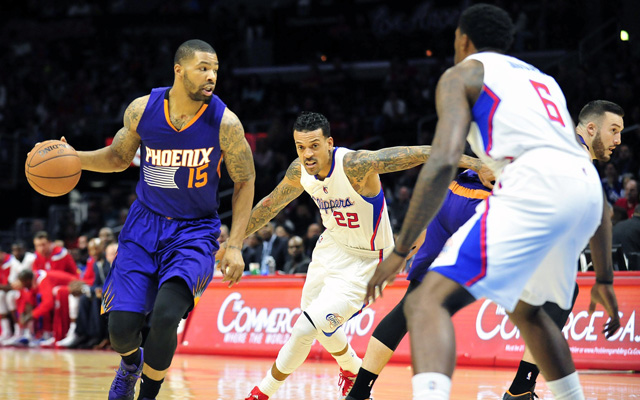
The Los Angeles Clippers don't look right. They're 5-4, with three of those wins coming against the short-handed Thunder, the Lakers, and Jazz. They fell to 3-4 in their last seven after a dispiriting loss to the Bulls who were without Derrick Rose and Pau Gasol. It was the most depressing loss you could imagine, at home, to a team on a road trip going West, without two of their three best players.
And that one loss isn't as much a problem as the fact that they haven't impressed hardly ever this season. Nothing seems right. The offense is clogged and stale after leading the league in points per possession last season. The defense isn't making an impact. It's rotten all the way through. But not "gotta extract the tooth" rotten. Just "you're going to need a lot of fillings" rotten.
It's nine games in, and the Clippers could turn this around quick with a five-game winning streak. All of a sudden, they would be one of the hottest teams in the league. The problem is not the losses, or their struggles.
It's the way they're struggling.
The Clippers basically have a cohesive lineup problem, despite an abundance of talent. The wing has been a position of priority for them for years, and they've gone through constant maintenance to try and upgrade it. The problem is that they've tried parsing together the wing they need (a creative ball-handler who can shoot and defend) by compiling with separate components: a shooter (J.J. Redick), a ball-handler (Jamal Crawford), and a defender (Matt Barnes). For a lot of teams, that works. Instead of a dominant big man on both ends you combine an offensive four with a defensive five. But what has wound up happening too often is J.J. Redick trying to create off the dribble, Crawford getting exposed defensively, and Barnes being targeted by the defense.
I first noticed the phenomenon with Barnes in the 2013 playoffs. The Grizzlies essentially built their defense to funnel the ball to Barnes and dare him to beat them with shooting. It's a risk, but once you commit to it and hold to it, it's effective. Barnes is a good enough offensive player to lure you into thinking you should spend more energy defending him, which opens up the rest of the floor for the more talented players and helps get you out of the paint. But if you essentially focus on Barnes as the "poison you pick," the Clippers' offense starts to sputter and coil.
Which is why the natural conclusion, despite the high likelihood of the Clippers still finishing as a top-four seed in the West is to say a trade must be made.
This is often treated as some sort of absolute, that "Crawford has to go" or "Barnes has to go," and with Redick increasingly struggling, "Redick has to go." None of these are absolutely true, but while one of them will be necessary if the Clippers are going to make the move to make the whole roster into the team it needs to be, there's a subtlety that has to be maintained here.
There's a gap between "the Clippers could use a trade" and "the Clippers must make a trade to reach their goals." The Clippers, if everything were to click and go right, could win a title with this group. But their odds are going to go way, way up if they do add that wing player (and preferably a rim protector instead of Spencer Hawes, but we'll get there).
So the Clippers could use a trade. They don't need a trade. If we go two more months and they're still languishing around .500, then yeah, that's a different deal. But we're here now, so let's get a feel for what they need.
Diagnosing the problem
Here's a look via NBA.com of the numbers for players on and off. The "+/-" is the points per 48 minutes for the team off vs. on, and "Offrtg" and Defrtg" is points per 100 possessions (how that metric is calculated is how Barnes goes from a negative to a plus). Click to enlarge.
Barnes comes out as a net positive here, in part large part because Chris Douglas-Roberts started off rough, then got hurt, and now the team is relying on Barnes for heavy minutes. Redick is obviously the most concerning piece here, the Clippers are nearly 10 points better per 100 possessions with him off the floor. Crawford's been good, despite being most often considered the "expendable" trade piece.
But let's take a closer look at where exactly the wings are struggling. Here are the Clippers' three-man groups that have played at least ten minutes together this season, sorted by how much they've been outscored per 100 possessions.

The craziest part of the Clippers' struggles has been their starters. The five-man Chris Paul, J.J. Redick, Matt Barnes, Blake Griffin, and DeAndre Jordan is ten points worse than their opponent per 100 possessions. Those names up there are mostly starters, Crawford as sixth man, or Spencer Hawes, the first big off the bench. In particular, three of the five worst three-man units feature Redick and Barnes together. Yes, Redick is struggling and that's something to have faith will resolve itself as his shot gets going and not pin solely on a larger issue, but it is, to a degree, proof that the combination isn't working exceptionally well right now.
So You Want To Make A Trade
OK, so if we're going to look to solidify the wings for the Clippers, who do you move? The common answer is to move Crawford because a. he's still a super-productive bench player averaging 18 points and b. you could really afford to lose the offense if you improve the wing defense. Except, if you upgrade the starting wing(s), then Crawford could become more valuable as that scoring punch off the bench. Crawford hasn't been the issue, and his defense is habitually underrated. (Note the 101.4 defensive rating in the first chart.)
So that leaves Redick and Barnes. Redick is obviously struggling the most of any Clippers wing, but there's a reason the Clippers gave so much to get Redick. He's a knockdoown shooter; he's never shot below 37 percent from three for a season, and is shooting 30 percent right now from deep. It's not like one of the most prolific shooters in college history who's been a great three-point shooter in the NBA is just going to "lose" his jump shot. So then you ask whether you want to target a defensive upgrade over a knockdown shooter...
Or you look for an upgrade on the wing offensively in which you don't lose Barnes' length, toughness, or defensive acumen.
You're not looking to improve on Barnes' defense, only to replace it and bring a small measure of offense.
The issue, naturally, is trying to find a suitor. The Clips have already traded their 2015 and 2017 first-round picks and can't trade them in consecutive years. So you're effectively looking to find a team that wants either veterans, cap relief, or some mix of the two, and cap relief will be tough because the Clippers are cap-strapped. One intriguing option is Milwaukee and Khris Middleton. Middleton's shown himself to be an impressive if little known scoring force, but is having a hard time cracking minutes in Milwaukee under Jason Kidd. The Bucks already have a storm of wings, including Jared Dudley... who they got from the Clippers. Middleton's a superb fit, but the Bucks would be looking for the draft pick they don't have.
But there are teams looking for a veteran wing, among them the Pelicans who are in all honesty using Luke Babbit and John Salmons as their bench small forwards.
One intriguing idea is to look at Dion Waiters, who doesn't seem to be fitting in with Cleveland exceptionally well despite his individual productivity. Waiters is big enough to slip over to small forward, and can both defend and create. The Cavaliers have been looking for someone to soak up minutes for LeBron James to reduce his workload, and Barnes is perfect for that, especially for a team hurting for defense. But the Cavs would also likely want a rim protector, and while Ekpe Udoh would be a quality fit for Cleveland, the Clippers need more defenders down low, not less.
Jeff Green remains very compelling, as the Celtics might be fine to just dump his contract, especially if the Clippers threw in a young guy. But there's this static reality when it comes to dealing with Danny Ainge and the C's. They are notoriously hard to strike a deal with.
Denver's also an intriguing candidate. Wilson Chandler is in the same model of player as Barnes, but much, much better offensively, and both under-used and logjammed in Denver.
But these are suggestions, without the actual dynamics of a trade in play, because without that draft pick, things are tough. And then, there's the elephant in the paint.
Big Problem
The Clippers signed Spencer Hawes last offseason, to help give them a center who could pass and score, which still doesn't solve their problem defensively. That issue of defending the rim is why DeAndre Jordan gets tossed out there so much, despite the fact that he's an excellent rim protector. Hawes' defensive rating is excellent, but as seen in the lineup combos, he's got to be with just the right personnel.
Any trade considerations the Clippers make wll get flummoxed by this simple problem. If they trade for a big, they'll likely lose wing strength, which they need, and if they upgrade their wing, they'll either still be without or will get worse in terms of rim protection.
None of this is to suggest that the Clippers need to panic. Again, they can just ride this out and try and get to April and hope things come together. But the biggest problem with the Clippers the past two years with what is effectively the same roster is this: it's solveable. Blake Griffin will get healthy from his back issue, stop taking so many long two's, and get back to being awesome. J.J. Redick will find his shooting touch, Chris Paul still has games and stretches were he looks like a top-five player.
But the Clippers are a riddle you can see the answer to from the outside of it. Getting past that limitation will either require a lot of team growth through coaching, an unforseen development of a player, or a trade.
The pressures and criticisms of the Clippers are at an all-time high. Exploring a trade may be their only way to rise to the bar they've set for themselves.









